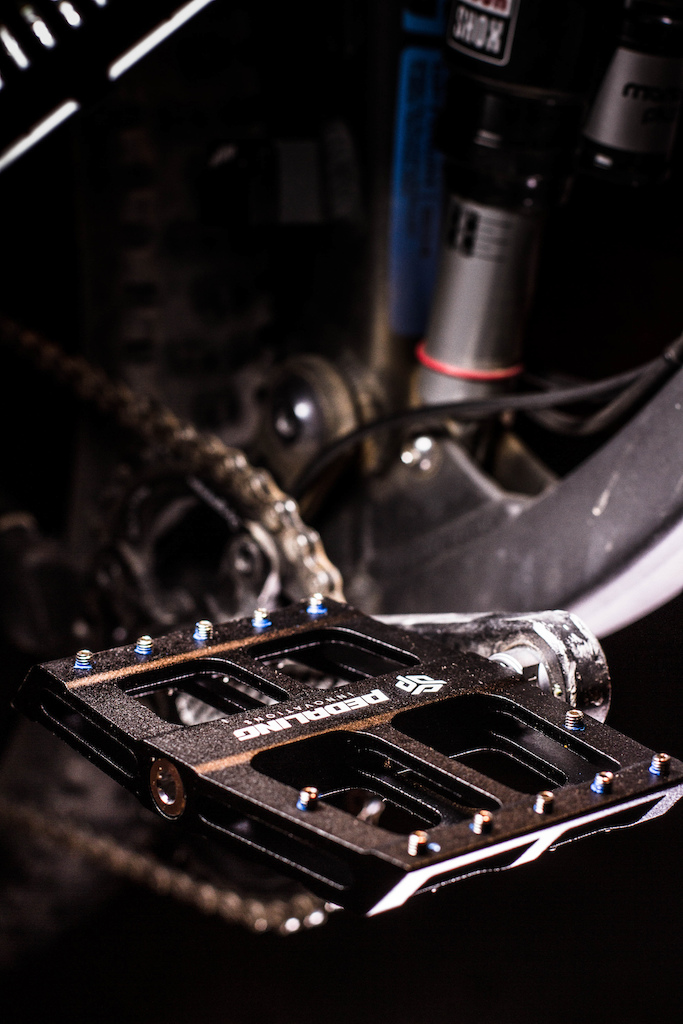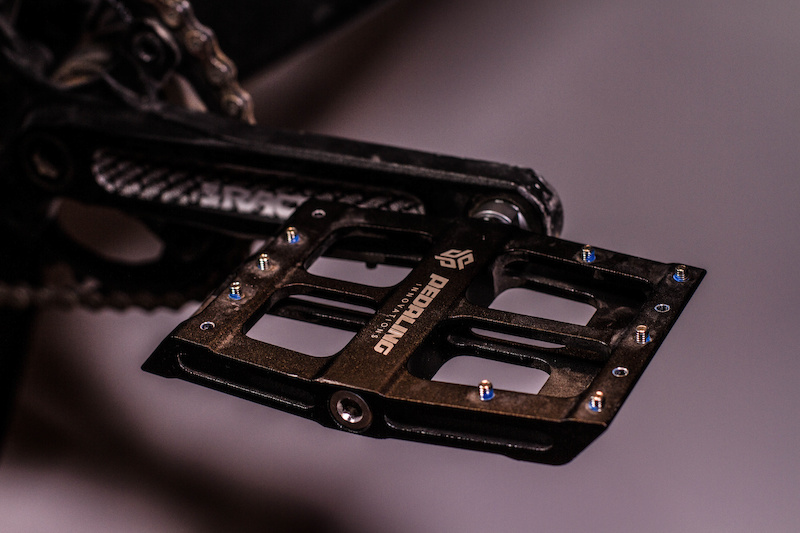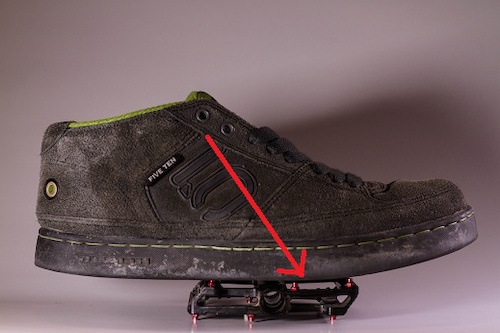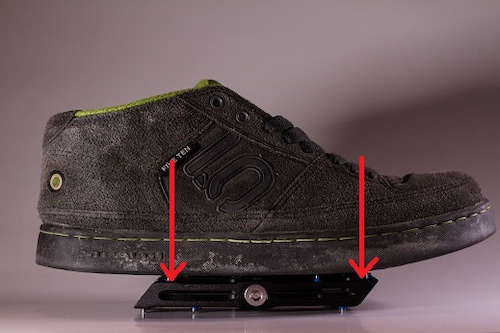Pedaling Innovations Introduces the Catalyst Pedal
Born from a simple insight, the Catalyst Pedal from Pedaling Innovations is looking to change the way we look at powering our bikes. By looking first at how the foot and lower leg optimally move and then applying that to the bike, the Catalyst Pedal provides the type of platform your foot was designed to thrive on.
Up until this point every pedal has been designed based on the outdated view that you had to push through the ball of the foot. However, this is only the case when your foot breaks contact with what it is on. So when you walk, run or jump then you do need to push through the ball of the foot.
But we now know that when the foot stays in contact with what it is on – like it does during the pedal stroke – that it wants to stay balanced between the front and back of the foot and push through the mid-foot. This creates a strong, stable arch and foot and balances the forces being applied by the foot.
We also know that you don't need to use your ankle and calf muscles to push and pull for power. This study (J.R. Van Sickle Jr, M.L Hull/ Journal of Biomechanics 2007) showed no difference in power or economy between the ball of the foot and the mid-foot position…which means that the ball of the foot isn't "better" or it would have won. At worst you won't lose anything by using the mid-foot position.
However, it did show an important difference in how that power was produced. They found that driving through the ball of the foot placed more stress on the calf muscles and Achilles tendon, while the mid-foot placement took that stress and put it on the hips.
This is interesting when you consider that the hips - and not the quads - have been shown to be the major drivers of the pedal stroke (ELMER, S. J., P. R. BARRATT, T. KORFF, and J. C. MARTIN. Medicine & Science in Sports & Exercise 2011).
Taken together, all of this points to a pedaling platform that stabilizes the foot by supporting both ends of the arch and optimizes the mid-foot placement to better recruit the hips, which are the main drivers of the pedal stroke.
And this is exactly what we did with the Catalyst Pedal.
To accomplish this it gives you the longest platform available – 5 inches/ 128 mm. While some oversized flat pedals come close to this length, through testing we found that there is a “critical mass” that is reached with the Catalyst Pedal which allows it to connect both ends of the arch of the foot.
The Catalyst Pedal is also no wider than a normal flat pedal – 3.75 inches/ 95 mm. This means that it is narrower than any other oversized flat pedal, disappearing underfoot and not exposing any extra pedal body to rock strikes.
Tested over the last 8 months on a variety of trails in the Fruita/ Grand Junction CO and Moab UT areas, the result is a patent pending design that supports your foot the same way the ground does. This creates a strong, stable platform for your foot that is not available with any other pedal.
This improved foot position and support has 3 main benefits:
1) POWER - By supporting both ends of the arch of the foot you naturally support the arch itself, which gets rid of flex in the arch. An arch that is only supported on one side is weak and flexible while one that is supported on both sides is strong and stable. By supporting the arch with the pedal body itself you get rid of the foot flex you usually need stiff soled shoes for. This improves power transfer since the pedal body itself is far stiffer than even the stiffest soled shoes, which means every bit of power your legs produce go straight into the crank arms.
2) EFFICIENCY - The mid-foot placement of the axle balances the foot, which takes stress off of the ankle joint and allows for better recruitment of the hips.As mentioned earlier, the hips have been shown to be the major muscles used when pedaling, not your quads (ELMER, S. J., P. R. BARRATT, T. KORFF, and J. C. MARTIN. Medicine & Science in Sports & Exercise 2011). The mid-foot position has been shown to shift the stress from the ankles to the hips (J.R. Van Sickle Jr, M.L Hull/ Journal of Biomechanics 2007). This means that optimizing the mid-foot position allows your body to better recruit the main muscles powering the pedal stroke.
3) COMFORT & STABILITY - The more balanced foot position achieved from this pedal design will result in a more balanced application of force into the pedals. Instead of pushing forward into the pedal through the ball of the foot you will push straight down through the entire foot. This will result in less stress on the feet since you aren’t pushing them into the toe box of your shoes with every pedal stroke, plus your feet won’t push over the top and come off during hard sprints on the trail.
All of this adds up to an improved experience for your foot on the bike. And since your foot is one of the major contact points with your bike this can have a dramatic impact on your riding.
2) EFFICIENCY - The mid-foot placement of the axle balances the foot, which takes stress off of the ankle joint and allows for better recruitment of the hips.As mentioned earlier, the hips have been shown to be the major muscles used when pedaling, not your quads (ELMER, S. J., P. R. BARRATT, T. KORFF, and J. C. MARTIN. Medicine & Science in Sports & Exercise 2011). The mid-foot position has been shown to shift the stress from the ankles to the hips (J.R. Van Sickle Jr, M.L Hull/ Journal of Biomechanics 2007). This means that optimizing the mid-foot position allows your body to better recruit the main muscles powering the pedal stroke.
3) COMFORT & STABILITY - The more balanced foot position achieved from this pedal design will result in a more balanced application of force into the pedals. Instead of pushing forward into the pedal through the ball of the foot you will push straight down through the entire foot. This will result in less stress on the feet since you aren’t pushing them into the toe box of your shoes with every pedal stroke, plus your feet won’t push over the top and come off during hard sprints on the trail.
All of this adds up to an improved experience for your foot on the bike. And since your foot is one of the major contact points with your bike this can have a dramatic impact on your riding.
In fact, we are so confident in this pedal design that we back it up with a money-back guarantee – if it doesn’t improve your power, stability and comfort then we’ll be happy to refund your investment.
Right now we are working hard to bring the Catalyst Pedal to the market by the end of the year. We have teamed up with VP Components - makers of VP Pedals – to handle our manufacturing and the first order is placed so it is just a matter of getting them made and delivered.
You can learn more about the story, science and logic behind the Catalyst Pedal Right by visiting www.pedalinginnovations.com. You can also pre-order your pair at a special pre-sale discount now through Saturday October 10th.
With over 400 pairs sold so far around the world, we are looking forward to bringing the evolution of the pedal to riders everywhere.
Frequently Asked Questions about the Catalyst Pedal
Q: Don't I need my ankles to help smooth out bumps on the trail/ act as extra suspension?
A: I'm not going to argue about someone's personal riding style and preference. However, as a strength coach I know that a more stable foot allows the rest of the body to relax and move better which will more than make up for a few lost inches of movement out of your ankles. Your body needs a certain amount of stability and if you destabilize the foot then it tries to make up for it with stiffness in other areas of the body.
I mean, try it for yourself - get up and balance on the balls of you feet while trying to get down into a mock Attack Position like you are on your bike. Now try to do it with your heels down and your foot balanced. There is a huge difference in how smoothly you can move and while you may not realize it, this is happening to you on the bike to some degree when you balance on the balls of your feet.
Using your ankles as extra suspension can also result in an ankle getting snapped back and sprained (I've been there before myself). I'd also like to point out that most pedals are set up for you to be on the ball of the foot and so it is hard to say what someone's preference would be on pedals that changed the platform and balance points. If you feel that it works for you and you are not interested in trying something new that could be better then that is fine but that technique certainly isn't "right" and there are some arguments against it.
--------------------------------------------------------------
Q: Don't you need a concave design and/ or more pins in the middle?
A: Not with this design. When you are on the ball of the foot then your pressure points on the pedal are more in the middle of the pedal body and pushing forward. This requires a lot of pins and/ or a concave design to combat.
However, the Catalyst Pedal balanced the weight on your foot and puts the pressure at the front and back edge of the pedal body. This means that you don't need as many pins on the middle or a concave design since your pressure points have changed and you are not fighting the forward weight shift that comes from being on the ball of your foot.
--------------------------------------------------------------
Q: Don't I need to use my ankles for leverage when pedaling/ Won’t pushing with my ankle help me add power to the pedal stroke compared to just letting the calf muscle do nothing?
A: This study (J.R. Van Sickle Jr, M.L Hull/ Journal of Biomechanics 2007) showed now difference between the ball of the foot or the mid-foot position in power or economy. It also showed that the mid-foot position placed less stress on the calf and Achilles tendon and instead suggested that the stress was placed on the hips instead.
This means that the mid foot position better recruits the hips and that the ball of the foot isn't "better". If it was it would have won, not just tied. In fact, from a functional movement standpoint taking the stress off of the smaller ankle joint and putting it at the stronger, bigger hip joint is how the body is meant to move. Your calf needs to act as a stabilizer for the ankle so it can help transfer the power from the hips and when you try to move it to “add” to the power you decrease that power transfer and place extra stress on a more sensitive joint.
And if you look at kids or people in 3rd world countries ride their bikes they are almost always mid-foot on the pedals - this is the natural riding position and unless someone at some point told you that you needed to push through the ball of the foot odds are you wouldn't have learned it.
Again, I can’t argue with your success and if the ball of the foot works for you and you don’t want to try something that could be better then that is fine. My point is simply that using your ankle for leverage isn’t “right” and in fact I could argue goes against how your body is built to optimally move.
--------------------------------------------------------------
Q: Don’t you need to pull up on the backstroke?
A: The short answer is no. The Korff (et al. Med Sci Sports Exerc 2007; 39:991-995) and Mornieux (et al. Int J Sports Med 2008; 29:817-822) Cycling Efficiency Studies clearly show that pulling up on the backstroke produces less power and burns more energy than simply driving hard on the downstroke and letting the trail leg come up just hard enough to get ready for the next hard downstroke push.
In all my years of looking I have found no studies or evidence that supports the theory that you need to pull up on the backstroke and I have an open challenge to anyone who can show me some. This was just a theory that sounded great but now that we can actually look at what is happening during the pedal stroke the evidence clearly shows that pulling up on the backstroke is not the "right" way to pedal. Follow us here on Pinkbike at @PedalingInnovations
--------------------------------------------------------------
Author Info:
Must Read This Week
Sign Up for the Pinkbike Newsletter - All the Biggest, Most Interesting Stories in your Inbox
PB Newsletter Signup








That's what she said.
You'd just very slightly break all of your toes.
Also: Shin Bites...
www.pinkbike.com/photo/12669542
"Plus everything" I guess?
From an academia POV many of the sources are pretty irrelevant considering some of them are nearly 10 years old.
that said, boost is still dumb
"if it doesn’t improve your power, stability and comfort then we’ll be happy to refund your investment."
...but you already said it wouldn't, it'll at best tie...
The idea that this us pedal is good because you only use the ball of your foot when pushing off the ground doesn't help sell it to me. I'm bouncing from one thing to the next when I'm going downhill. Seems like this product needs to figure out their target market. Flat pedal riders generally don't care that much about pedaling efficiency, hence the floppy shoes with flat pedals.
A lot of research to support longer is better, but still not desirable if they don't rotate after one muddy ride, or pins rip out too easy, etc.
We're (mostly) experienced bikers that will be looking for $100+ flat pedals and the sales pitch is strictly ergonomic. Please...enlighten us...is there a specific VP pedal who's parts will swap right over?
Everyone can make a pedal that runs well for 2 rides....let us know the construction of yours please.
And laugh at the "patent pending" bit. Adding a few mm to a pedal doesn't make you innovative and if they do land the patent it'll get tossed out prefty quick. I can't make an 860mm handlebar and patent it based off length alome.
(1) J.R. Van Sickle Jr, M.L Hull in 2007. This study is based on spin-bike steady cadence riding. Is it appropriate to extrapolate this to XC (stand-up sprint climbs, changing dropper positions, etc) or DH (for obvious reasons)? Roadies, maybe. This also makes me wonder why everyone has a dropper now. Is it not to change positions so we can recruit other muscles for specific tasks? Maybe I'll take a measurement of my calf now at the end of the riding season and measure again in March when I'm nice and soft... I suspect I've used my calf to help at some point this season.
(2) Elmer, S. J., P. R. Barratt, T. Koroff, and J. C. Martin in 2011. Fair statement but, again, base on spin-bike steady cadence which may/may not apply to mtb (seated, standing, dropper high or low). And mostly irrelevant to lift-assisted DH riders.
(3) "Taken together, all of this points to a pedaling platform that stabilizes the foot by supporting both ends of the arch and optimizes the mid-foot placement to better recruit the hips, which are the main drivers of the pedal stroke." Correct me if I'm wrong, but is the arch not the most stable when the subtalar joint is supinated (ie traditional forefoot spd placement on the downstroke)? This the most stable your arch can get. Tell me about the most common shoe to use with flats? 5-10s? Mostly made with softer materials (no carbon stabilizers like in roadie/XC shoes). So the foot will stationary in that?
tl;dr. I also call BS.
Jesus, for all the crap we love to give companies here, we sure are accepting of their claims.
The fact is, there are different "sciences" in this world and we can observe countless examples of it in MTB. There is The Science where someone makes a research according to scientific method, and even if input or application isn't perfectly relevant to the case, it is still a scientific method like research papers James referenced. And then there are things people call "science" for their own purposes like to appear smarter (like to sell the product) or just to shut someone up with a high fly word. It becomes some magic force, a leviathan that regular blokes claim to be friends with. Like God for dumber part of religious people. So when someone says "this and that is better - it's science" in relation to bike parts or gear, it generally lights up synapses in my brain responsible for expressing the sentence: "what a stupid prick"
Can I get some peddles that lean outwards?
Some peddles that lean inwards for the knock knees among us too.
But if you're out for long days of riding and worried about burning out your calves, then by all means move the cleat back. I just think the calves/ankles play too big a role in balance, mobility over the seat, and acceleration to take them out of the equation.
I only have a dozen rides on them, so maybe I just need to get used to them, but the only place I don't find them to be quite as good is on steep tech climbs. I feel like I have a better level of control with my shorter pedals as it's easier to get my weight forward (and over the front end) when trying to get the bike over taller obstacles, like boulders, logs, ledges, etc... This is more noticeable on steeper terrain. Which makes sense since it's easier to pivot your foot/leg/body over the axle with shorter pedals.
128mm seems awfully long. I can see how they'd work well on longer non-technical gravel grinders, but I have a feeling they would hinder bike control in tech section where you really need to be dynamic over the bike.
my $0.02 worth
What was I thinking studying Gwin, Barel, Graves riding when it was these third world kids who are the real pros. I'm never going to load my front wheel up around a corner.
Did you really put that in the article? Or should I say infomercial. WOW
Buy 2 and get a free shamwow!!
How he can endorse oval rings (which I have nothing against) *and* this pedal with this sell is beyond me. I call bullshit.
Also, "I mean, try it for yourself - get up and balance on the balls of you feet while trying to get down into a mock Attack Position like you are on your bike. Now try to do it with your heels down and your foot balanced." Umm, everyone knows that an athletic stance is with most of your weight on the balls of your feet. How about, try sprinting with your heels down - doesn't work. You just can't react quickly, or change direction quickly with weight on your heels, and "your foot balanced."
To get decent hops you need the spring from your ankles which you get by having the ball of your foot on the pedal.
I'd sacrifice pedal efficiency and a bit of comfort to be able to have ultimate control over my bike personally.
Spd's for me (and occasionally, cheap welgo flats to mix thing up a little).
James is taking a risk with his own time and money and hoping for a success, while the PB haters howl behind their keyboards and most likely doing so while wasting their employer's time and wages.
On top of that, will you still be able to drop your ankles for efficient braking? How about subtle changes to balance when manualling?
Translated...
You should learn to ride bikes based on the technique of someone who has never ridden a bike before, and is used to walking.
Noone "told" me to pedal on the ball of my foot. No one ever told me anything about how to pedal. I pedal on the ball of my foot because that is where my brain naturally positions my foot after years of experience. I move to mid foot for braking and tech, then back to the ball for pedaling. No thought required, just habit. Pedaling mid foot feels utterly retarded. Because it is. Why the hell would you ignore a whole lever arm?
The thing that I'm mainly wondering about is the grip and control when riding off road or riding more extreme disciplines. My foot placement on my pedal has evolved to where I have most control over my pedals and least chance of slipping off. Since ankle movement plays a big part in keeping your pedals sticked to your shoes while catching some airtime, I wonder if less ankle movement (like on these pedals) wouldn't increase the chance of your feet getting loose from the pedals while jumping your bike.
I do believe this pedal would be an improvement for those who ride on the roads with flat pedals. Just wondering how it would perform on more extreme cycling disciplines.
The only way to find out for us if we could test it somewhere.
I like the way you guys think, need more companies like you because guys like you are the ones who bring progression to our sport
This is the problem with doing things in a lab. You miss significant variables in your reproduction of the event. In the end they have proven that roadies should clip in in the middle of their arch.
I would try some bigger pedals except for the price of pedals currently. My V8s are over ten years old, when/if they break I'll get more as it's better economy for a slight discomfort on longer descents
When I first saw them, I thought it might be a gimmick, but that thought ended with my first ride. I was amazed at the power transfer on the climbs, and I went up a few technical climbs that I've always had to hike-a-bike. Just when I thought I was convinced these were good pedals, I came downhill and realized these are GREAT pedals. The balance, weight transfer, and control was totally improved. I couldn't believe what a game changer these are...
I do have a bit of advice for anyone wanting to try these:
1. Get good MTB shoes like the 5-10's. Running shoes will not deliver.
2. If you are currently clipless, get used to a HUGE change. Re-thjink your whole idea of how to pedal.
3. Don't be a shallow dork and think your bike looks funny or different with these pedals. Let your friends laugh at you in the parking lot then watch you laugh as you completely shred the hell out of them up AND down the hill, just because of a new pedal.
F yeah....
BL
Waki you should get a zero-drop shoe and try going for short jogs on the ball of your feet to strength your arches.
Of course Fabien Barel actually modifies his clipless shoe so the cleat can go back almost a full centimeter to get the pedal more centered under his foot to help with cornering, so maybe I am blowing smoke.
Please explain?
Sounds like rubbish to me...
When I climb the same hill(s) with both platforms and clipless pedals however, I CLEARLY am slower and more tired at the top using platforms.
I don't care what this guy says about 'the right way'.
What I'm getting at is that for me, mid-foot gives better grip (without stupidly oversized pedals) but I can still confidently have fun!
Bullshit
;-)